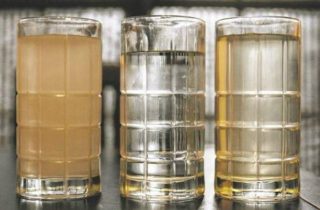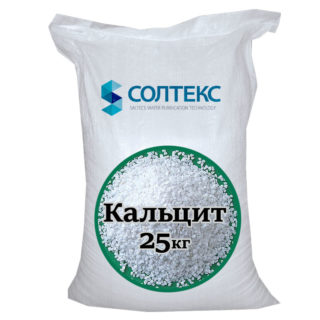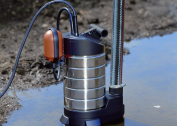The high concentration of minerals in the water produced from wells with a depth of more than 20 meters is not a myth, but a reality that owners of country houses and cottages are constantly confronted with. With the advent of spring, “rusty” water appears even in a relatively young and well-equipped well. High mineralization with magnesium and calcium salts makes the water hard and practically unsuitable for use, and in the case of iron, it is dangerous to human health.
Do-it-yourself water purification from iron from a well
Before proceeding with the purification of well water, make sure that its composition contains a large amount of ferrous iron.
- To ensure the presence of a chemical, you need to keep a small amount of well water in an open container for a while. At first it does not manifest itself in any way, but with prolonged contact with air it precipitates in a brown color.
- A clear sign of a high concentration of the substance in the water is an unpleasant specific odor from the well.
- By eye, it is possible to calculate the presence of bacterial iron in water if there are rainbow films on the surface of the water mirror.
A yellow shade of water indicates an increased content of organic iron (not bacterial!) In it, but when sedimented it does not precipitate.
To clean water from iron from a well in the old-fashioned way is quite simple and not financially expensive.
Upholding
 This is the least expensive and easiest way to implement the deferrization of well water. A self-made system is additionally equipped with a tank, the volumes of which correspond to the total daily consumption of all households. The method has both advantages and disadvantages.
This is the least expensive and easiest way to implement the deferrization of well water. A self-made system is additionally equipped with a tank, the volumes of which correspond to the total daily consumption of all households. The method has both advantages and disadvantages.
Advantages:
- Mounting the tank in the attic will provide gravity, and this will save the liquid from hydrogen sulfide.
- An easy to implement method that does not require large waste.
- In stock there is always a purified volume of liquid.
Among the disadvantages of sedimentation is not 100% water purification. Also, the tank needs to be cleaned regularly, since solid sediment of a dark color forms on its walls.
Aeration
Using this method provides excellent cleaning results. The filtration process is quite simple - the environment enriched with oxygen, reacts with iron, as a result, the latter decomposes and precipitates. At the outlet after purification, solid sediment particles are retained by mechanical filters.
Benefits:
- Purification of well fluid from iron and hydrogen sulfide.
- Sustainable cleaning, as it is a reagent-free method.
Only one of the disadvantages is distinguished - a small percentage of iron still remains in the composition.
The introduction of catalysts and reagents
In industry, I use chlorine or ozone to clean the fluid from the well. The peculiarity of these substances lies in the high oxidizing ability, however, special plants are required to produce them. At home, chemicals are not recommended because of the high toxicity.
As an analog, it is preferable to use grains or granules of activated glauconite clay, the surfaces of which are equipped with particles of oxidized manganese.
Folk ways
The most common, safe, and low-cost way to clean well fluid is to purify the lime stream and then pass it through a thick layer of calcite of natural origin.Such a process leads to the fact that iron is transformed into an insoluble salt. Because of this, water becomes softer and already usable. This method of purification can also be used in cases where the composition of the well fluid completely meets the requirements for use.
Excellent results can be achieved using the dry method. In this case, heated potassium permanganate is used. Approximately 4-5 g of active substance is placed in a reservoir made of ceramic or refractory glass. Potassium permanganate slowly and carefully warms up in a sand bath. The container must be covered with a lid. This volume of active substance will be enough to purify 5 liters of water.
Ozonation
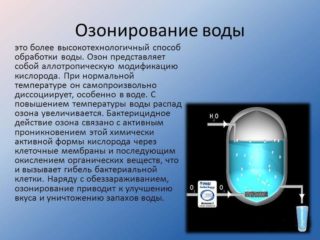 This process is effective, but it is not easy to implement. It is almost impossible to clean the liquid on your own at home in this way. The use of chlorine is no longer in such great demand, since this substance partially remains in the liquid and poisons the human body when consumed.
This process is effective, but it is not easy to implement. It is almost impossible to clean the liquid on your own at home in this way. The use of chlorine is no longer in such great demand, since this substance partially remains in the liquid and poisons the human body when consumed.
Ozonation is the most reliable and high-quality method of purification. The method is implemented by the action of ozone on particles contained in a liquid.
By ozonation, 99.99% organic iron is removed. The disadvantage is that high-quality cleaning requires the installation of expensive equipment. To make such a system on your own is real, but very difficult.
Home-made filter for iron removal from a well
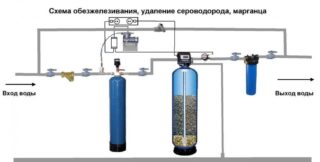 A filter for cleaning water from iron for a do-it-yourself home does not have to be expensive. Using the old-fashioned methods, it is possible to defer well water using improvised or inexpensive consumables.
A filter for cleaning water from iron for a do-it-yourself home does not have to be expensive. Using the old-fashioned methods, it is possible to defer well water using improvised or inexpensive consumables.
Ready-made store filters have a fairly high cost. However, reagent well water treatment systems can be made independently.
To make a filter you will need:
- Two horizontal tanks made of plastic and equipped with a large lid.
- A separate container designed for the active substance - bulk reagent.
- Fine sieve for collecting large solid particles.
- A set of plastic pipes, some of them are equipped with taps.
The installation location of such a system depends on the frequency and intensity of use. If the water will be cleaned in winter, it is best to store the system in a heated room. The most suitable place is an attic, a second floor or a heated room.
Algorithm for filter assembly for purification of well water:
- The base for the tank is installed. It is important that the base is reliable, strong and stable, since the weight of a container filled with water reaches several hundred kilograms.
- Capacities are firmly fixed at the base. Connection to the water supply network. A special soldering iron is used to connect fittings and pipes.
- A container filled with reagent and a sieve for collecting solid impurities are loaded. The amount of reagent used depends on the degree of water pollution and the required volumes of purified water.
A home-made filtration system is not equipped with automation, so drain and clean themselves.
